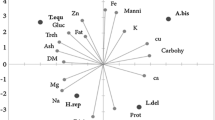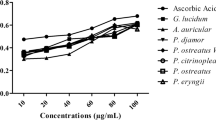Abstract
Four species of mushrooms are commercially available in Thailand, namely Lentinus edodes, Pleurotus eryngii, Pleurotus sajor-caju and Pleurotus djamor and their nutritional compositions, nonvolatile taste components as well as antioxidant capacities were determined. In this research, each mentioned mushrooms were dehydrated by hot air drying prior to analysis. All dried mushrooms were found to be good sources of proteins, with contents varying in the ranges of 21.23–28.23 g/100 g dry weight (dw) while the fat content was very low (1.47–2.57 g/100 g dw). Trehalose (12.97–42.57 mg/g dw) and mannitol (73.27–75.53 mg/g dw) were considered as the major mushroom sugar/polyol. Total soluble sugar contents were in the order: L. edodes > P. sajor-caju > P. eryngii and P. djamor. Total content of free amino acids also varied and ranged from 28.46 to 57.09 mg/g dw. Monosodium glutamate (MSG)-like components were the highest in P. eryngii (10.72 mg/g dw), and lowest in L. edodes (7.16 mg/g dw) and P. djamor (7.41 mg/g dw). Equivalent umami concentration values (EUC) in four dried edible mushrooms ranged from 200.28 to 299.60 g MSG/100 g dw, and the highest EUC was found in P. eryngii, followed by P. djamor, P. sajor-caju and L. edodes, respectively. In addition, L. edodes contained the highest total phenolic contents (26.63 mg/g dw) as well as antioxidant capacities as evaluated by DPPH radical scavenging activity (DPPH-RSA, 7.58 mg/g trolox dw), 2,2′-azino-bis(3-ethylbenzothiazoline-6-sulphonic acid) radical scavenging activity (ABTS-RSA, 2.19 mg/g trolox dw) and Ferric ion reducing antioxidant power (FRAP, 18.77 mg/g trolox dw). This result obtained revealed that all dried mushrooms contained a relatively strong umami taste and could be used as functional foods with a palatable umami taste or in the formulation of nutraceuticals.
Similar content being viewed by others
References
M.Y. Kim, I.M. Chueng, S.J. Lee, J.K. Ahn, E.H. Kim, M.J. Kim, S.L. Kim, H.I. Moon, H.M. RO, E.Y. Kang, S.H. Seo, H.K. Song, Comparison of free amino acid, carbohydrates concentrations in Korean edible and medicinal mushrooms. Food Chem. 113, 386–393 (2009)
W. Li, Z. Gu, Y. Yang, S. Zhou, Y. Liu, J. Zhang, Non-volatile taste components of several cultivated mushrooms. Food Chem. 143, 427–431 (2014)
F.S. Reis, L. Barros, A. Martins, I.C. Ferreira, Chemical composition and nutritional values of the most widely appreciated cultivation mushrooms: an inter-species comparative study. Food Chem. Toxicol. 50, 191–197 (2012)
M. Dermiki, N. Phanphensophon, D.S. Mottram, L. Methven, Contributions of non-volatile and volatile compounds to the umami taste and overall flavor of shiitake mushroom extracts and their applications as flavor enhancers in cooked minced meat. Food Chem. 141, 77–83 (2013)
K.K. Mishra, R.S. Pal, R. Arunkumar, S.K. Chandrashekara, J.C. Bhatt, Antioxidant properties of different edible mushroom species and increased bioconversion efficiency of Pleurotus eryngii using locally available casing materials. Food Chem. 138, 1557–1563 (2013)
J.T. Lin, C.W. Liu, Y.C. Chen, C.C. Hu, L.D. Juang, C.C. Shiesh, D.J. Yang, Chemical composition, antioxidant and anti-flammatory properties of ethanolic extracts from Pleurotus eryngii fruiting bodies harvested at different time. LWT-Food Sci. Technol. 55, 374–382 (2014)
T.C. Finimundy, G. Gambato, R. Fontana, M. Camassola, M. Salvador, S. Moura, J. Hess, J.A.P. Henriques, A.J.P. Dillon, M. Roesch-Ely, Aqueous extracts of Lentinula edodes and Pleurotus sajor-caju exhibit high antioxidant capability and promising in vitro antitumor activity. Nutr. Res. 33, 76–84 (2013)
H.H. Arbaayah, K.Y. Umi, Antioxidant properties in the oyster mushroom (Pleurotus spp.) and split gill mushroom (Schizophyllum commune) ethanolic extracts. Mycosphere 4, 661–673 (2013)
J.H. Yang, H.C. Lin, J.L. Mau, Non-volatile taste components of several commercial mushrooms. Food Chem. 72, 465–471 (2001)
W. Horwitz, G. Latimer, Official methods of analysis of AOAC International, 18th edn. (AOAC, International, Gaithersburg, 2005)
J.L. Mau, H.C. Lin, J.T. Ma, S.F. Song, Non-volatile taste components of several speciality mushrooms. Food Chem. 73, 461–466 (2011)
L. Bosch, A. Alegría, R. Farré, Application of the 6-aminoquinolyl-N-hydroxysccinimidyl carbamate (AQC) reagent to the RP-HPLC determination of amino acids in infant foods. J. Chromatogr. B 831, 176–183 (2006)
S. Yamaguchi, T. Yoshikawa, S. Ikeda, T. Ninomiya, Measurement of the relative taste intensity of some α- amino acid and 50-nucleotides. J. Food Sci. 36, 846–849 (1971)
S. Li, N.P. Shah, Effects of various heat treatments on phenolic profiles and antioxidant activities of Pleurotus eryngii extracts. J. Food Sci. 78, 1122–1129 (1971)
W. Binsan, S. Benjakul, W. Visessanguan, S. Roytrakul, M. Tanaka, H. Kishimura, Antioxidative activity of Mungoong, an extract paste, from the cephalothorax of white shrimp (Litopenaeus vannamei). Food Chem. 106, 185–193 (2008)
I.F.F. Benzie, J.J. Strain, The ferric reducing ability of plasma (FRAP) as a measure of antioxidant power: the FRAP assay. Anal. Biochem. 239, 70–76 (1996)
X.M. Wang, J. Zhang, L.H. Wu, Y.L. Zhao, T. Li, J.Q. Li, Y.Z. Wang, H.G. Liu, A mini-review of chemical composition and nutritional value of edible wild-grown mushroom from China. Food Chem. 151, 279–285 (2014)
E.V. Crian, A. Sand, Edible mushrooms: Nutritional value, in The biology and cultivation of edible mushrooms, 1st edn., ed. by S.T. Chang, W. Hyyes (Academic Press, New York, 1987), pp. 137–165
S. Beluhan, A. Ranogajec, Chemical composition and non-volatile components of Crotian wild edible mushrooms. Food Chem. 124, 1076–1082 (2011)
H.K. Chen, Studies on the characteristics of taste-active components in mushroom concentrate and its powderization, Master Thesis, National Chung-Hsing University, Taichung, Taiwan (1986)
X. Li, T. Feng, S. Zhou, Y. Liu, W. Li, R. Ye, Y. Yang, Effect of drying methods on the tasty compounds of Pleurotus eryngii. Food Chem. 166, 358–364 (2015)
S.J. Huang, S.Y. Tsai, Y.L. Lee, J.L. Mau, Nonvolatile taste components of fruit bodies and mycelia of Cordyceps militaris. LWT-Food Sci. Technol. 39, 577–583 (2006)
S.Y. Tsai, T.P. Wu, S.J. Huang, J.L. Mau, Nonvolatile taste components of Agaricus bisporus harvested at different stages of maturity. Food Chem. 103, 1457–1464 (2007)
Y.H. Tseng, J.L. Mau, Contents of sugars, free amino acids and free 5′ nucleotides in mushrooms, Agaricus bisporus, during postharvest storage. J. Sci. Food Agric. 79, 1519–1523 (1999)
S.Y. Tsai, C.C. Weng, S.J. Huang, C.C. Chen, J.L. Mau, Nonvolatile taste components of Grifola frondosa, Morchella esculenta and Termitomyces albuminosus mycelia. LWT-Food Sci. Technol. 39, 1066–1071 (2006)
J.L. Mau, The umami taste of edible and medical mushrooms. Int. J. Med. Mushroom 7, 113–119 (2005)
J.H. Litchfield, Morel mushroom mycelium as a food flavoring material. Biotechnol. Bioeng. 9, 289–304 (1967)
F. Pei, Y. Shi, X. Gao, F. Wu, A.M. Mariga, W. Yang, L. Zhao, X. An, Z. Xin, F. Yang, Q. Hu, Changes in non-volatile taste components of button mushroom (Agaricus bisporus) during different stages of freeze drying and freeze drying combined with microwave vacuum drying. Food Chem. 165, 547–554 (2014)
Y.L. Lee, S.Y. Jian, J.L. Mau, Composition and non-volatile taste components of Hypsizigus marmareus. LWT-Food Sci. Technol. 42, 594–598 (2009)
Y. Zhang, C. Venkitasamy, Z, Pan, W. Wang, Recent developments on umami ingredients of edible mushrooms. A review. Trends Food Sci. Technol. 33, 78–92 (2013)
J.L. Mau, H.C. Lin, C.C. Chen, Non-volatile taste components of several medical mushrooms. Food Res. Int. 34, 521–526 (2001)
L.M. Cheung, P.C.K. Cheung, V.E.C. Ooi, Antioxidant activity and total phenolic of edible mushroom extracts. Food Chem. 81, 249–255 (2003)
I. Mujic, Z. Zekovic, Z. Lepojevic, S. Vidovic, J. Zivkovic, Antioxidant properties of selected edible mushroom species. J. Cent. Eur. Agric. 11, 387–392 (2010)
C.H. Gan, A.B. Nurul, R. Asmah, Antioxidant analysis of different types of edible mushrooms (Agaricus bisporous and Agaricus brasilienis). IFRJ 20, 1095–1102 (2013)
G. Sudha, S. Vadivukkarasi, R.B.I. Shree, P. Lakshmanan, Antioxidant activity of various extracts from an edible mushroom Pleurotus eous. Food Sci. Biotechnol. 21, 661–668 (2012)
M. Anese, M.C. Nicoli, R. Massini, C.R. Lerici, Effects of drying processing on the Maillard reaction in pasta. Food Res. Int. 32, 193–199 (1999)
T. Vashisth, R.K. Singh, R.B. Pegg, Effects of drying on the phenolics content and antioxidant activity of muscadine pomace. LWT-Food Sci. Technol. 44, 1649–1657 (2011)
Acknowledgments
The authors are grateful to Srinakharinwirot University (Grant No. 027/2557) for financial support given to carry out this study. In addition, the authors thank Prof. Dr. Anthony Gethin Hopkin for kindly revising English of the manuscript.
Author information
Authors and Affiliations
Corresponding author
Rights and permissions
About this article
Cite this article
Naknaen, P., Itthisoponkul, T. & Charoenthaikij, P. Proximate compositions, nonvolatile taste components and antioxidant capacities of some dried edible mushrooms collected from Thailand. Food Measure 9, 259–268 (2015). https://doi.org/10.1007/s11694-015-9231-x
Received:
Accepted:
Published:
Issue Date:
DOI: https://doi.org/10.1007/s11694-015-9231-x




